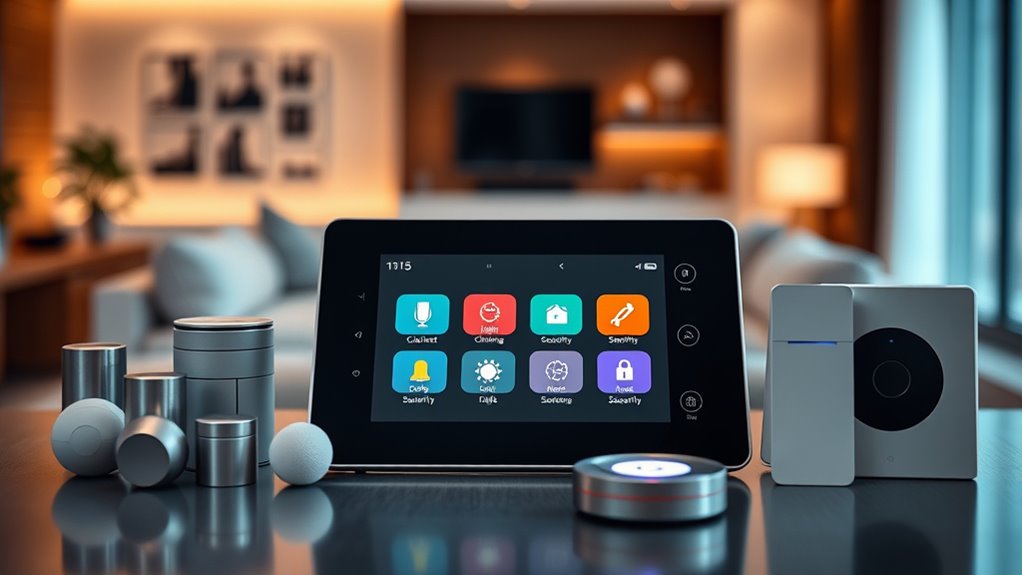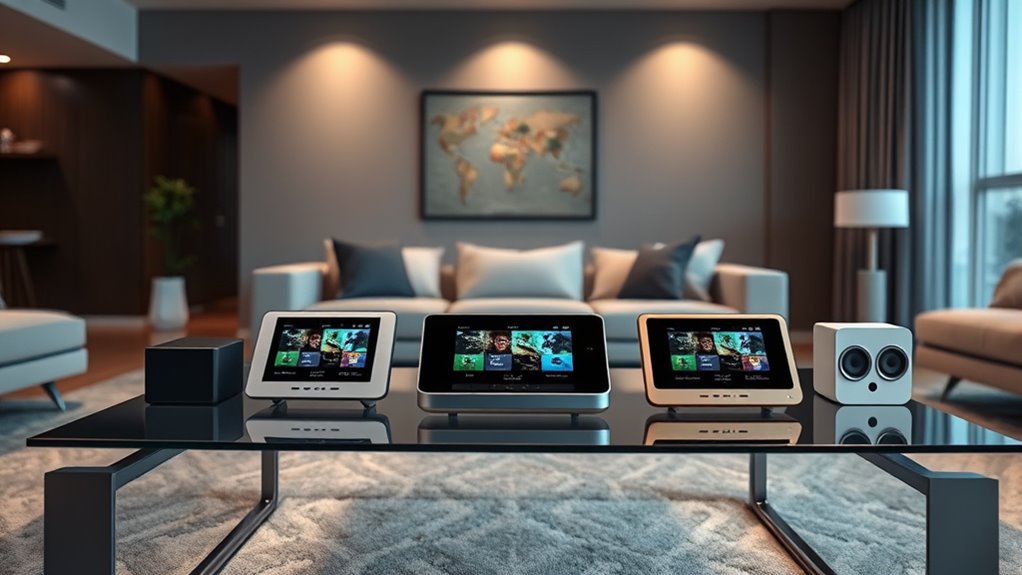If you’re looking to upgrade your smart home, I recommend exploring premium hubs like Hubitat Elevation C-8 Pro, Homey Pro, and SmartThings Hub 3rd Gen, which support multiple protocols like Zigbee, Z-Wave, and Wi-Fi for broad device compatibility. Devices like the Philips Hue Bridge and Emporia Vue 3 add extra features like lighting automation and energy monitoring. Stay tuned if you want insights into which hub best fits your needs and lifestyle.
Key Takeaways
- Top-tier hubs like Hubitat Elevation C-8 Pro and Homey Pro offer extensive protocol support for seamless device integration.
- They provide robust local control for faster automation and enhanced privacy, ensuring reliable performance during internet outages.
- Premium hubs feature user-friendly setup, customizable dashboards, and strong community or ecosystem support for optimal user experience.
- Advanced automation capabilities and compatibility with voice assistants and ecosystems elevate overall smart home functionality.
- Specialized features like energy monitoring (e.g., Emporia Vue 3) add value for energy management and smart home optimization.
Hubitat Elevation Home Automation Hub (C-8 Pro)
If you’re looking for a home automation hub that offers extensive device compatibility and prioritizes local control, the Hubitat Elevation C-8 Pro is an excellent choice. It supports over 1,000 devices from more than 100 brands, including Aqara, Philips Hue, and Nest, using protocols like Zigbee 3.0, Z-Wave 800, Wi-Fi, IR, and Matter. I appreciate that all data is processed locally, ensuring faster responses and increased security, even during internet outages. Its advanced automation capabilities, custom dashboards, and strong community support make it perfect for users who want reliability, flexibility, and privacy in their smart home setup.
Best For: smart home enthusiasts and power users seeking extensive device compatibility, local control, and advanced automation capabilities.
Pros:
- Supports over 1,000 devices from 100+ brands using Zigbee, Z-Wave, Wi-Fi, IR, and Matter protocols.
- Processes all data locally for faster response times, enhanced security, and reliability during internet outages.
- Highly customizable with advanced automation, custom dashboards, and a strong community for support and troubleshooting.
Cons:
- Initial setup can be complex and overwhelming for non-technical users.
- Some users report a learning curve for programming dashboards and navigating settings.
- Might be overkill for casual users seeking simple, plug-and-play solutions like SmartThings.
Homey Pro Smart Home Hub for Home Automation
Homey Pro stands out as the ideal choice for tech-savvy homeowners who want maximum flexibility and control over their smart home ecosystem. It supports an impressive array of protocols like Z-Wave Plus, Zigbee, Wi-Fi, BLE, Infrared, Matter, and Thread, making it the most protocol-rich hub available. Compatible with over 50,000 devices from more than 1,000 brands, it offers seamless integration with popular systems like Siri, Alexa, and Google Home. Its local processing ensures automations run reliably without cloud dependency, enhancing privacy. Overall, Homey Pro provides a powerful, customizable platform that adapts to any existing or future smart home setup.
Best For: tech-savvy homeowners seeking maximum flexibility, extensive protocol support, and local control for their smart home systems.
Pros:
- Supports a wide range of protocols including Z-Wave Plus, Zigbee, Wi-Fi, BLE, Infrared, Matter, and Thread, making it highly versatile.
- Processes automations locally, ensuring fast, reliable performance even during internet outages.
- Compatible with over 50,000 devices from more than 1,000 brands, offering extensive integration options.
Cons:
- Higher price point, typically ranging from $350 to $600, which may be a barrier for some users.
- Limited official support for certain devices and brands, especially in North American markets, leading to integration challenges.
- Some users experience setup difficulties, connectivity issues, and incomplete support for regional devices or automations.
SmartThings Hub 3rd Gen Home Automation Hub
The SmartThings Hub 3rd Gen stands out as an ideal choice for homeowners seeking seamless integration across multiple smart devices. It supports Zigbee, Z-Wave, and Cloud-to-Cloud protocols, making it compatible with a wide range of products. You can easily monitor and control all your devices through a single app, simplifying home management. The hub also automates routines based on triggers like door openings or presence detection, boosting convenience and security. Compatible with Alexa and Google Home, it offers versatile voice control options. Overall, this hub provides a reliable, centralized solution to elevate your smart home experience effortlessly.
Best For: homeowners seeking a reliable, versatile hub to seamlessly integrate and control multiple smart home devices across various protocols.
Pros:
- Supports Zigbee, Z-Wave, and Cloud-to-Cloud protocols for broad device compatibility
- Centralized control via a single smartphone app simplifies home automation management
- Compatible with Alexa and Google Home for versatile voice control options
Cons:
- May require technical setup and configuration for optimal performance
- Limited built-in sensors; dependent on connected devices for advanced monitoring
- Firmware updates and integrations can occasionally be delayed or complex
Homey Bridge Smart Home Hub
For those seeking a versatile smart home hub that supports a wide range of devices, the Homey Bridge stands out with its compatibility across Z-Wave Plus, Zigbee, Wi-Fi, BLE, and Infrared. It easily integrates with popular voice assistants like Alexa, Google Home, and Siri Shortcuts (sold separately), allowing voice control of various devices. The setup is straightforward, and automations are customizable, but some users report connectivity issues with certain brands, like smart locks and thermostats. Its signal range is limited, and a subscription is required for premium features. Overall, while flexible, its reliability and device support can be inconsistent, affecting the overall experience.
Best For: those seeking a budget-friendly, versatile smart home hub with broad compatibility and easy setup, despite potential connectivity limitations.
Pros:
- Supports multiple protocols including Z-Wave Plus, Zigbee, Wi-Fi, BLE, and Infrared for extensive device compatibility
- Easy to set up with straightforward automation and voice control options (voice assistants sold separately)
- Privacy-focused with no data sharing and a free trial of premium features
Cons:
- Reported connectivity issues with certain devices like smart locks and thermostats
- Limited signal range, potentially requiring an upgrade to Homey Pro for better coverage
- Mixed user reviews with some experiencing frequent disconnections and limited device recognition
Philips Hue Bridge, Smart Lighting Hub with Automation and Voice Control
If you’re looking to elevate your smart lighting experience, the Philips Hue Bridge stands out as the ideal hub for those who want reliable, scalable control over both indoor and outdoor lights. It supports up to 50 lights and accessories, offering automations, multi-room, and remote out-of-home control. Setup is simple: connect to power and your router, then configure through the Hue app. Using Zigbee technology, it guarantees a stable, low-latency mesh network that keeps your lights responsive even when Wi-Fi drops. Supporting voice control and Matter integration, the Hue Bridge makes managing complex lighting scenes effortless, enhancing your smart home’s flexibility and reliability.
Best For: smart home enthusiasts seeking reliable, scalable, and seamless control of both indoor and outdoor Philips Hue lighting with automation and voice command capabilities.
Pros:
- Supports up to 50 lights and accessories, allowing extensive scalability
- Utilizes Zigbee mesh technology for reliable, low-latency operation even without Wi-Fi
- Compatible with Matter and popular voice assistants like Alexa and Apple Home for versatile integration
Cons:
- Higher initial cost compared to basic smart bulb kits
- Requires a dedicated Hue Bridge for outdoor and advanced automation features
- Setup and configuration, while straightforward, may be complex for complete beginners
Emporia Vue 3 Home Energy Monitor
With its precise real-time energy monitoring and support for solar and net metering, the Emporia Vue 3 Home Energy Monitor stands out as an ideal choice for homeowners seeking detailed insights into their energy consumption. It offers ±2% accuracy, monitors up to 16 circuits, and integrates seamlessly with smart home automation through the Emporia Energy App. Installation is straightforward for those familiar with electrical panels, and its safety certification ensures reliability. The system helps identify energy-saving opportunities, track critical loads, and manage costs effectively. With positive reviews and ongoing updates, the Vue 3 provides a thorough, reliable solution for optimizing your home’s energy use.
Best For: homeowners seeking precise, real-time energy monitoring and smart automation integration to optimize energy use and reduce costs.
Pros:
- Provides ±2% accurate real-time energy data across up to 16 circuits, including solar and 220V loads.
- Supports seamless smart home automation and cost management through the Emporia Energy App.
- Easy to install for those familiar with electrical panels, with safety certification and ongoing software updates.
Cons:
- Limited sensor capacity may not cover very large or complex home electrical systems.
- Space constraints in smaller panels can make sensor installation challenging.
- Requires a stable 2.4 GHz WiFi connection for optimal performance, which may be problematic in some environments.
MOES ZigBee 3.0 Hub/Wired Gateway for Smart Home
The MOES ZigBee 3.0 Hub/Wired Gateway stands out as an ideal choice for those seeking a reliable, compact smart home bridge that seamlessly integrates with the Tuya ecosystem. Weighing just 5 ounces and measuring under 4 inches, it offers over 200 meters of coverage and easy USB-powered installation. Designed to connect with lights, switches, sensors, and motorized shades, it assures stable ZigBee connectivity and works well with platforms like Alexa and Home Assistant. Although it faces some compatibility limits and proprietary standards, its straightforward setup, reliable performance, and affordability make it a solid addition to a Tuya-based smart home.
Best For: homeowners seeking a compact, reliable ZigBee hub that easily integrates with the Tuya ecosystem and supports stable control of lights, switches, sensors, and motorized shades.
Pros:
- Easy installation via USB power with a compact, lightweight design
- Over 200 meters of open space coverage and stable ZigBee connectivity
- Compatible with platforms like Alexa and Home Assistant for seamless automation
Cons:
- Limited support for standard ZigBee devices due to proprietary standards
- Some compatibility issues with specific gadgets such as Bluetooth devices or certain smart locks
- Chinese-language interface during device setup can be challenging for non-native users
SONOFF Zigbee 3.0 USB Dongle Plus Gateway
For tech-savvy homeowners seeking reliable, seamless integration of their Zigbee devices, the SONOFF Zigbee 3.0 USB Dongle Plus Gateway stands out as an excellent choice. It’s a universal Zigbee USB adapter compatible with systems like Home Assistant and IoBroker, ensuring flexible setup options. Equipped with the TI CC2652P chipset and pre-flashed with Z-Stack 3.x.0 firmware, it supports Zigbee 3.0 for broad device compatibility. The external SMA antenna interface allows signal optimization, and the aluminum housing minimizes interference. Easy to install with detailed tutorials, this dongle delivers strong, stable wireless connectivity, making it ideal for expanding and enhancing your smart home ecosystem.
Best For: tech-savvy homeowners seeking reliable, seamless integration of their Zigbee devices into their smart home systems.
Pros:
- Compatible with popular platforms like Home Assistant and IoBroker for flexible setup
- Supports Zigbee 3.0 with pre-flashed Z-Stack 3.x.0 firmware for broad device compatibility
- External SMA antenna interface and aluminum housing optimize signal strength and stability
Cons:
- Requires some technical knowledge for installation and configuration
- May need additional antennas for extended range in large or complex setups
- Limited user-friendly, plug-and-play features for beginners
If you’re looking for a sleek, versatile smart button that works seamlessly across major ecosystems, the arre Smart Button with Matter and Thread support is an excellent choice. It offers rapid, low-latency connections thanks to Thread, ensuring reliable communication with devices like Apple HomeKit and Samsung SmartThings. The button features three trigger modes—single, double, and long press—that can be mapped to various actions. Easy to set up via the Apple Home app, it provides tactile feedback and customizable mounting options, including magnetic attachments and decorative stickers. Its compatibility with HomePod Mini makes it a powerful, straightforward addition to your smart home.
Best For: users seeking a sleek, reliable, and versatile smart button compatible with Apple HomeKit and Samsung SmartThings for effortless smart home control.
Pros:
- Supports Matter and Thread for fast, low-latency device communication
- Easy setup via the Apple Home app with customizable trigger modes
- Flexible mounting options including magnetic attachment and decorative stickers
Cons:
- Occasional connectivity stability issues reported over time
- Battery compartment access and battery status indicators could be improved
- Some users noted potential quality control concerns with packaging and device condition
Lockin Wi-Fi Gateway and Electronic Lock Component for Smart Lock and Lock Box
Lockin Wi-Fi Gateway stands out as an ideal choice for homeowners seeking reliable remote control and monitoring of their smart locks and lockboxes. It seamlessly pairs with compatible devices like Q3/Q1 Smart Door Knob and L1 Smart Box, offering real-time updates on lock status, battery life, and activity logs. Easy to set up—plug in, connect within 2 minutes, and place within 10 feet of the lock—it enhances security without the need for batteries. Users can remotely manage access codes and monitor their property from anywhere, making it a practical addition to any smart home system. Its discreet design ensures it blends seamlessly into your security setup.
Best For: homeowners and property managers seeking reliable remote control and monitoring of compatible smart locks and lockboxes without the need for batteries.
Pros:
- Easy to set up, connects within 2 minutes and works within 10 feet of the lock
- Enables remote management of access codes, lock status, and activity logs
- Compatible with select Lockin smart locks and lock boxes, enhancing home security
Cons:
- Does not plug directly into an outlet, requiring discreet placement solutions
- Not compatible with Lockin Veno series locks or lockboxes
- Lacks batteries; users must provide their own power source
Kasa Smart Plug HS103P4, Wi-Fi Outlet 4-Pack
The Kasa Smart Plug HS103P4 4-Pack stands out as an excellent choice for anyone looking to expand their smart home effortlessly. These plugs offer seamless voice control with Alexa, Google Assistant, and IFTTT, letting me manage lamps, fans, or holiday lights hands-free. Setting them up via the Kasa app is straightforward, requiring just a 2.4GHz Wi-Fi connection. Their compact design allows two plugs in one outlet, saving space. I can control devices remotely, create schedules, or automate routines, even during internet outages. Trusted by millions, these plugs combine reliability, safety, and affordability—making them an ideal addition to any smart home setup.
Best For: homeowners and renters seeking easy-to-setup, reliable smart plugs for controlling appliances, holiday lights, or outdoor equipment with voice commands and automation.
Pros:
- Easy to install and connect via the Kasa app with step-by-step guidance.
- Compact design allows two plugs in the same outlet, saving space.
- Compatible with Alexa, Google Assistant, and IFTTT for seamless voice control and automation.
Cons:
- Requires a 2.4GHz Wi-Fi network, not compatible with 5GHz networks.
- Limited to 15A/1500W, which may not support very high-power appliances.
- Some users report occasional connectivity issues during firmware updates or internet outages.
Aqara Smart Lock U100 with Keyless Entry and HomeKit Support
For homeowners seeking seamless integration with Apple devices, the Aqara Smart Lock U100 stands out thanks to its full support for Apple Home and HomeKit. I love how I can release my door using my iPhone or Apple Watch, even during a power outage, thanks to Apple Home Key. It also works with Google Home, Alexa, and IFTTT when paired with an Aqara Zigbee 3.0 hub, making it versatile. The lock offers multiple access options, including fingerprint, remote password, and mechanical key, all secured with AES encryption. Its durable zinc alloy body, IP65 weatherproof rating, and built-in auto-lock make it reliable for any climate or situation.
Best For: homeowners seeking a highly secure, weatherproof smart lock with seamless Apple ecosystem integration and versatile access options.
Pros:
- Fully supports Apple HomeKit and Home Key for convenient unlocking via iPhone or Apple Watch, even during power outages
- Multiple unlocking methods including fingerprint, remote password, mechanical key, and optional NFC card, with AES encryption for security
- Durable zinc alloy body with IP65 weatherproof rating and extended battery life up to 8 months
Cons:
- Requires compatible Aqara Zigbee 3.0 hub for integration with Google Home, Alexa, and IFTTT
- Additional accessories like NFC cards are sold separately
- May be over-featured or unnecessary for users with simple lock needs or no Apple ecosystem integration
Kasa Smart 2-Gang Wi-Fi Light Switch (HS200-2)
If you’re looking for a reliable, easy-to-install smart switch that combines sleek design with versatile compatibility, the Kasa Smart 2-Gang Wi-Fi Light Switch (HS200-2) is an excellent choice. Its 2-gang design lets you control two separate circuits with a flush, modern look. Compatible with Alexa, Google Assistant, and Samsung SmartThings, it offers seamless voice control. No hub needed—just a neutral wire and simple setup via the Kasa or Tapo app. You can control your lights remotely, set schedules, and activate “Away Mode” for security. It’s a straightforward, stylish addition to elevate your smart home experience.
Best For: homeowners seeking a sleek, easy-to-install smart switch compatible with popular voice assistants and capable of controlling two separate circuits.
Pros:
- Easy to install with app-guided setup, no hub required.
- Compatible with Alexa, Google Assistant, and Samsung SmartThings for versatile voice control.
- Supports scheduling, remote control, and security features like “Away Mode.”
Cons:
- Requires a neutral wire for installation, which may not be available in all homes.
- Might need professional electrician assistance if unfamiliar with electrical wiring.
- Limited to 2-gang design, controlling only two circuits simultaneously.
Emporia Vue 3 Home Energy Monitor
Designed for homeowners who want detailed energy insights, the Emporia Vue 3 Home Energy Monitor offers real-time data with 1-second granularity, making it ideal for those aiming to optimize energy use and reduce costs. Certified for safety and reliability, it supports various electrical systems and installs easily in most home panels. With 24/7 monitoring through an app, it measures total energy, solar production, and individual circuits with ±2% accuracy. Users can automate energy management, track appliance consumption, and identify savings opportunities. Its extensive data and straightforward installation make it a top choice for smarter, more efficient energy use at home.
Best For: homeowners seeking detailed, real-time energy monitoring and automation to optimize energy use and reduce costs.
Pros:
- Supports a wide range of electrical systems and panel configurations, including single-phase and 3-phase setups.
- Provides 24/7 real-time data with high granularity, enabling precise energy management.
- Certified for safety (UL and CE Listed) and includes comprehensive accessories and warranties.
Cons:
- Installation may require some electrical knowledge and working inside circuit panels.
- Limited to WiFi connectivity, which may affect performance in areas with weak signals.
- Some users have experienced minor issues with solar CT readings at night, though these have been addressed via updates.
Aqara 4MP Camera Hub G5 Pro Security Camera (White)
The Aqara 4MP Camera Hub G5 Pro Security Camera (White) stands out as an ideal choice for smart home enthusiasts seeking a reliable, all-in-one security solution. It offers crisp 4MP HD video with a wide 133° field of view and True Color Night Vision, ensuring clear footage day and night. Its AI detection capabilities track faces, vehicles, and more, while supporting HomeKit Secure Video, RTSP, and encrypted storage. As a hub, it connects Zigbee and Thread devices, integrating seamlessly with platforms like Apple Home, Alexa, and Google Home. Featuring PoE for stable power and a weatherproof design, it’s a versatile, high-performance security camera built for both indoor and outdoor use.
Best For: smart home enthusiasts seeking a reliable, high-quality, all-in-one security camera that integrates seamlessly with Apple HomeKit and supports advanced AI detection and PoE connectivity.
Pros:
- Excellent 4MP HD video quality with bright, detailed night vision and wide 133° field of view
- Supports multiple smart home platforms including Apple HomeKit Secure Video, Alexa, and Google Assistant
- Acts as a hub for Zigbee and Thread devices, enabling extensive smart home integration
Cons:
- App interface can be complex and nested, making setup and navigation challenging for some users
- Limited mounting options due to its size and design, especially for angled or side-wall installation
- Some users report audio issues and wish for additional features like siren activation via HomeKit
Factors to Consider When Choosing Premium Home Automation Hubs

When selecting a premium home automation hub, I consider factors like protocol compatibility and device ecosystem support to guarantee seamless integration. I also weigh the control options—whether local or cloud-based—and how flexible the automation capabilities are. Additionally, installation complexity plays a role in choosing a hub that fits my technical comfort level and setup needs.
Protocol Compatibility Range
Choosing a premium home automation hub with the right protocol compatibility range is essential for ensuring seamless device integration and reliable connectivity throughout your home. A good hub should support multiple protocols like Zigbee, Z-Wave, Wi-Fi, Thread, and Matter, enabling you to connect a wide variety of devices across different brands and ecosystems. The protocol range impacts how well these devices communicate, especially in larger or multi-story homes. For instance, Zigbee and Z-Wave typically offer 10 to 100 meters indoors, while Thread and Wi-Fi can extend further with proper network setup. Supporting emerging protocols like Matter also promotes interoperability, reducing dead zones and connection issues. Ultimately, a robust hub provides stable communication across your home’s layout, ensuring a smooth smart home experience.
Local Vs Cloud Control
Deciding between local and cloud control is crucial because each approach offers distinct advantages and trade-offs that can greatly impact your smart home’s performance. Local control processes automations directly within the hub, reducing latency and making your system more responsive. It also minimizes dependence on internet connectivity, ensuring your automations work even during outages. Additionally, local control enhances privacy and security since data stays within your home network. Conversely, cloud control relies on remote servers to execute automations, which can introduce delays and potential disruptions if your internet goes down. It offers the convenience of remote access and updates, but raises privacy concerns and increases vulnerability to server outages or cyberattacks. Your choice influences system reliability, responsiveness, privacy, and resilience during connectivity issues.
Automation Flexibility Levels
The level of automation flexibility a premium home hub offers directly impacts your ability to create complex and personalized smart home experiences. With higher flexibility, you can set up advanced “if-this-then-that” rules, create virtual devices, and handle multi-trigger scenarios that respond to multiple inputs simultaneously. Supporting multiple protocols like Zigbee, Z-Wave, Thread, and Matter allows for diverse device integration and more intricate automation setups. Customization options such as user-defined dashboards, scripting, and third-party app integrations further enhance your control, enabling tailored workflows. Additionally, automations based on sensor data, schedules, and device states expand what’s possible. Keep in mind, greater flexibility often means a steeper learning curve, but it’s well worth it for those seeking extensive control and personalization.
Device Ecosystem Support
Supporting a wide range of device ecosystems is vital when selecting a premium home automation hub, as it directly impacts compatibility and seamless integration. I look for hubs that support protocols like Zigbee, Z-Wave, Thread, and Matter to guarantee I can connect various devices effortlessly. Compatibility with voice assistants such as Alexa, Google Assistant, Apple HomeKit, and Samsung SmartThings is essential for smooth voice control. I also value support for third-party and community-developed apps, which expand my device options beyond official lists. Connecting ecosystem-specific devices, like Apple Home Key or Zigbee sensors, enhances interoperability within my setup. Future-proof support for protocols like Matter guarantees the hub will stay compatible as new devices emerge, protecting my investment in smart home technology.
Installation Complexity
Installation complexity can vary greatly depending on the hub’s features and the devices it supports, so I pay close attention to how much effort is involved in setting up a new system. Some hubs require wiring or network configuration, especially those supporting Ethernet or PoE connections, which can be more challenging than plug-and-play wireless options. Firmware updates or custom configurations via advanced settings also add to the initial setup effort. Additionally, hubs supporting multiple protocols like Zigbee, Z-Wave, or Thread often need extra steps for pairing devices and optimizing networks. If the hub includes physical components or sensors, mounting or wiring can further complicate installation. Overall, I look for a balance between advanced features and straightforward setup, ensuring I won’t be overwhelmed during installation.
Future-Proofing Features
Choosing a premium home automation hub that’s truly future-proof means looking beyond current features and considering how well it can adapt to emerging technology standards. I look for hubs that support protocols like Matter, ensuring compatibility with upcoming devices. Multi-protocol support—covering Zigbee, Z-Wave, Thread, and Wi-Fi—helps the hub stay flexible as ecosystems evolve. Regular firmware updates and an open platform architecture are essential, keeping the system secure and aligned with industry advancements. Compatibility with voice assistants and seamless integration with bridges or other hubs ensure interoperability grows with the ecosystem. Additionally, support for high-bandwidth, low-latency protocols like Z-Wave 800 and Zigbee 3.0 prepares the hub for future high-performance devices. These features collectively safeguard my investment and future-proof my smart home.
Frequently Asked Questions
How Do Premium Hubs Integrate With Existing Smart Home Ecosystems?
Premium hubs seamlessly integrate with existing smart home ecosystems by supporting multiple protocols like Zigbee, Z-Wave, and Wi-Fi. I connect my devices through a centralized app, which allows me to control everything from one place. These hubs often come with compatibility lists, ensuring my devices work smoothly together. I love how they unify my smart home, making automation simple and reliable without needing separate apps or hubs.
What Security Features Are Standard in High-End Home Automation Hubs?
Imagine a fortress guarding your smart home—high-end hubs come with robust security features like end-to-end encryption, secure boot, and regular firmware updates. They often include biometric access, multi-factor authentication, and intrusion detection, making your devices nearly impenetrable. I’ve found these features give me peace of mind, knowing my automation system is protected from hacking attempts and unauthorized access, keeping my home safe and secure at all times.
Can These Hubs Support Future Technology Updates and Standards?
Yes, these hubs are designed with future-proofing in mind. They often support over-the-air updates, allowing them to adapt to new standards and technologies as they emerge. I’ve found that top-tier hubs regularly receive firmware updates, ensuring compatibility with future devices and protocols. This means your smart home stays current, secure, and functional without needing a complete overhaul, giving you peace of mind for years to come.
How Do Premium Hubs Handle Multi-Device Management and Prioritization?
Did you know that premium hubs can manage over 200 devices simultaneously? I find that impressive! They handle multi-device management by prioritizing devices based on usage patterns and automation rules. I’ve seen how these hubs seamlessly allocate bandwidth and processing power, ensuring critical devices like security cameras or smart locks stay responsive. This prioritization creates a smooth, reliable smart home experience—no lag or interruptions, even with many devices connected.
What Is the Typical Setup and Troubleshooting Process for Advanced Hubs?
I start by connecting the hub to my Wi-Fi network and powering it on. Then, I use the dedicated app to set up my devices, ensuring they’re compatible and properly linked. If issues arise, I check connections, update firmware, or reset devices. Troubleshooting often involves reviewing logs in the app or resetting the hub. Patience and following manufacturer instructions usually resolve most problems quickly.
Conclusion
After diving into these top-tier home automation hubs, I believe the right choice truly depends on your needs—whether it’s seamless integration, security, or energy monitoring. It’s almost like there’s a perfect puzzle piece waiting for you. I’ve found that investing in a premium hub can transform your space into a smarter, more efficient home. Curious? Trust your instincts and pick the one that feels like the best fit—you might just unseal a whole new level of convenience.
Meet Asra, a talented and adventurous writer who infuses her passion for exploration into every word she writes. Asra’s love for storytelling and her insatiable curiosity about the world make her an invaluable asset to the Voyager Info team.
From a young age, Asra was drawn to the power of words and their ability to transport readers to far-off lands and magical realms. Her fascination with travel and cultures from around the globe fueled her desire to become a travel writer, and she set out on a journey to turn her dreams into reality.






![SmartThings Hub 3rd Generation [GP-U999SJVLGDA] Smart Home Automation Hub Home](https://m.media-amazon.com/images/I/21hChu0ounL._SL500_.jpg)




















